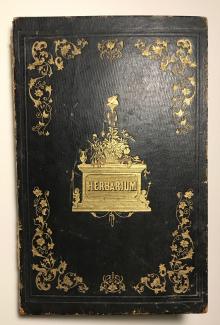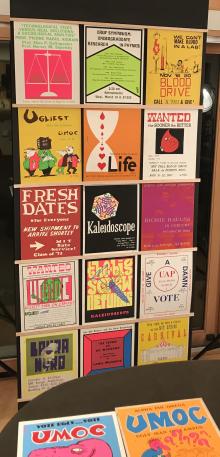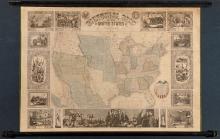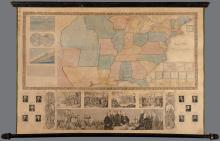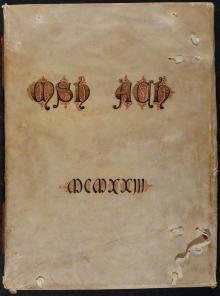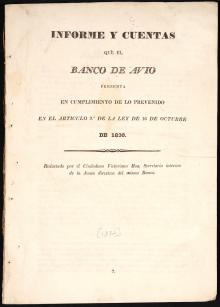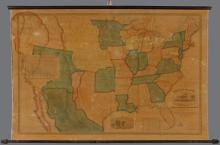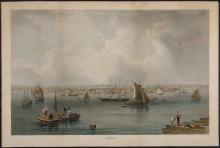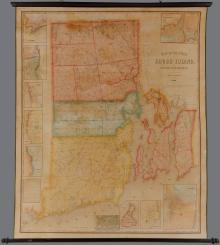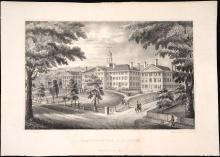The Back Room
The Back Room presents both Americana and international materials. This inventory is a selection of rare, scarce and one of a kind materials published in the 18th, 19th and occasionally the 20th century. The Back Room also includes 19th century American wall maps, an area of special interest. The Back Room inventory will be updated frequently.
Displaying 1 - 20 of 84Pages
Provenance: Massachusetts, new to market.
Contents:
This large collection of seventy-six (76) visually exuberant M.I.T. student life posters from 1968 to 1971 were published by the M.I.T. chapter of Alpha Phi Omega (APO) to adorn the infinite corridor and other M.I.T. campus locations, pinned to bulletin boards, walls, doors and other receptive surfaces.
Ensigns & Thayer's Pictorial Map of the United States 1847 was published when all eyes were on the West.1/ This scarce map is a portrait of the United States on the threshold of its complete national borders. Notably this wall map marks the date one year since the outbreak of the Mexican - American War (1846-1848) and the U.S. Congress' vote (1846) to admit the State of Texas, a slave holding state, as the newest American state.
Phelps & Ensign's pictorial wall map Travellers' Guide and Map of the United States 1845 represents the year in which the phrase "America's manifest destiny" first entered the national conversation to explain America's active westward expansion "to overspread the continent" and become a coast to coast nation from the Atlantic to the Pacific Ocean. 1/ This 1845 pictorial wall map presents a large, detailed map of the United States with Texas as its western boundary and only that portion of Mexico that abuts Texas.
Henry Francis Walling's1/ large scale, and extra large Map of The County of Bristol, Massachusetts, 1858 ("Bristol County Map ") is a simply decorated, topographical, trigonometric survey of Bristol County, Massachusetts presenting the county's south eastern shoreline on Buzzard's Bay, its major 19th c. cities such as Fall River, Taunton and New Bedford and small inland towns that together comprise the southeastern edge of Massachusetts.
This lot of four (4) distinct annual finance and banking titles (1850 in duplicate) published by the Mexican government consists of reports for the years 1830 to 1850 that are scarce, original records relevant to scholarship of Latin American finance and internal Mexican public finance that were published during turbulent times in independent Mexico's early political and fiscal history.
This vividly colored Ensign, Thayer & Co. Map of New England 1/was found rolled up and tucked away for safe storage by a family member for future generations, and here it is. The riot of imagery and geometric patterns, original vivid orange outlines and orange, red and green wash are characteristic of certain Ensigns 2/ & Thayer2/ pictorial maps and fully expressed in this remarkable example.
This scarce map represents the United States during its ultimate westward territorial expansion and is likely the first edition of Reed & Barber's Map of the United States of America with its Territories & Districts. Including also a part of Upper & Lower Canada and Mexico. 1850. 1/ I have found no records or commentary on this edition, or any recognition that there are two different 1850 editions of Reed & Barber's map.
This first edition of the T. and E.H. Ensign 1/ Map of the United States From the Latest Authorities.1846 with its large inset Map of Texas is a map of ambition. First, the political ambition on December 29, 1845 of the United States Congress to extend the nation coast to coast starting with a vote that day of a majority of both chambers of Congress to annex Texas as the 28th State. Congress knew opening this path required taking substantial Mexico territory all the way to the Pacific Coast.
The Varieties Theatre of New Orleans was established by the Variété Association Theatre Club of New Orleans, a stockholder association of individuals committed to producing local theatre and who oversaw hiring a manager, building a repertory company and attending performances. This provides some context for the three broadsides and the long history and reputation of this theatre. A series of fires and name changes, and manager changes permit us to date these New Orleans broadsides to 1867.
The First Book of Negroes is a children's book written and prepared by Langston Hughes (1901-1967), a child of the American mid-West and a student of American society throughout his life. His young adult life began in New York City, where he attended Columbia University and continued his personal goal of being a writer of poetry, prose and essays. Langston Hughes was a political activist in the pre-WWII era and throughout his entire life.
This distinctively inscribed example of the 1857 print Boston, is a period, colored steel plate engraving by Charles Mottram (1807-1876), one of London's most esteemed plate engravers who has translated in the medium of engraving the large 1853 water color painting Boston by British born American artist John William Hill (1812-1879) who apprenticed as a youth with his father John Hill, an English aquatint engraver. 1/ J.W.
Native son Henry F. Walling (1825-1889), Civil Engineer is the author of the large scale, survey Map of the State of Rhode Island and Providence Plantations.1855 wall map that reads as a cartographic gazetteer of Rhode Island at the middle of the 19th century. Just below the map's title, a Note also explains the collaborations and 19th c. history of the survey work required to prepare this Rhode Island statewide map. Walling relied upon work from 19th c.
First Edition, numbered and signed "Jack Kerouac" in blue ink on publisher's colophon, in original acetate covers, found with separate publisher's promotional sheet and a clipping dated October 21, 1969 from the Fitchburg (Mass.) Sentinel with the obituary for Jack Kerouac. Title page reads "Excerpts From Visions of Cody". Publisher's colophon reads: "750 copies of this book were printed for New Directions in December, 1959 at the press of Igal Roodenko, New York and signed by the author.
Hawaiian Government Survey and Hawaii Territory Survey Maps
MAUI HAWAIIAN ISLANDS. 1885.1903.
Hawaiian Government Survey. W.D. Alexander. Surveyor-General.
Primary Triangulation by W.D. Alexander and S.E. Bishop.
Boundaries and Topography by W.D. Alexander, C.J. Lyons, M.D. Monsarrat, F.S. Dodge, S.E. Bishop, E.D. Baldwin and W.R. Lawrence.
Map by F.S. Dodge. [Scale 1:60000] 1885. Brought up to date in 1903 by John M. Donn.
Andrew B. Graham Co., Lithographers, Washington, D.C. [1906]
This unique example of Birds Eye View of Casco Bay: Portland, Maine and Surroundings. c. 1905 was owned and used by Officer Lt. Armstrong as a military "site plan" for the U.S. Army's program to prevent malaria during WWII 1/ at it primary East Coast base, Casco Bay, Maine. The base was both defensive and offensive in its programs throughout WWII.
Mitchell's commanding 1845 wall map titled Mitchell's Reference and Distance Map of the United States consists of the titular, primary map of the United States that fills almost the entire 6 foot wide sheet and of a one-quarter sized, inset map titled A General Map of the of the United States with the contiguous British & Mexican Possession of utmost political significance that graphically appears to emerge as the metamorphosis of the United States into its destined coast to coast boundaries. This transcontinental map shows the Republic of Texas with its stovepipe.
This rare lithograph print is the first state, first edition of DARTMOUTH COLLEGE. printed c.1834-1835 by Nathaniel Currier in New York City where he set up his first lithography shop with a business partner named Adam Stodart in 1834 under the name Stodart & Currier.1/ Currier learned lithography when he was at age 15 apprenticed to Pendleton's Lithography in Boston, the partnership of brothers William S. Pendleton (1795-1879) and John B. Pendleton(1798-1866). Currier moved to New York City in 1834 and by some accounts worked briefly with John B.
This 17th century map of the Sommer Islands, engraved in Amsterdam and importantly published in England "to be sold by George Humble in Pops-head Alley" is the early, rare edition that lists the names of the island's original English settlers and shows their houses, a castle, a church and other buildings throughout the settled lots. A miniature image of the Bermuda islands appears below the map title block where the title and accompanying text is written in both English and Latin.

